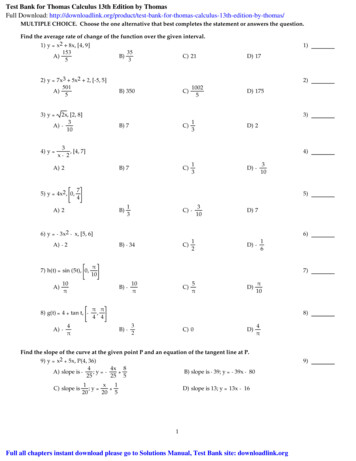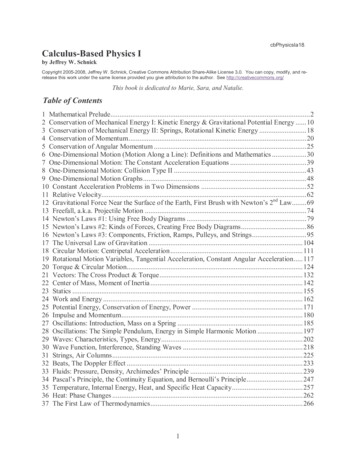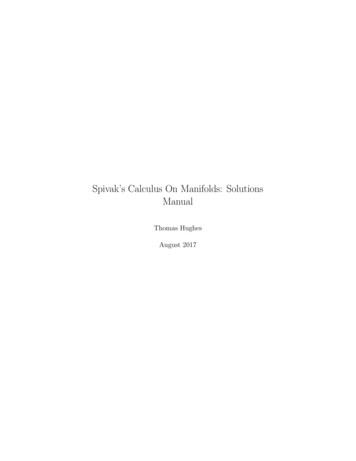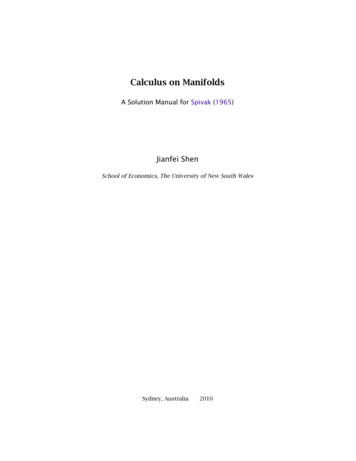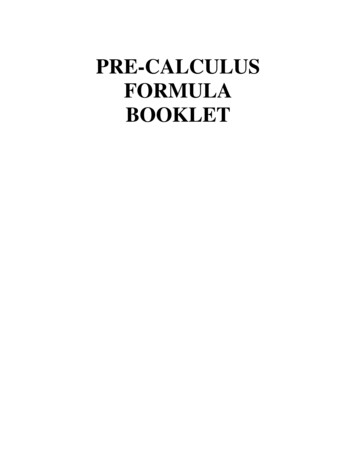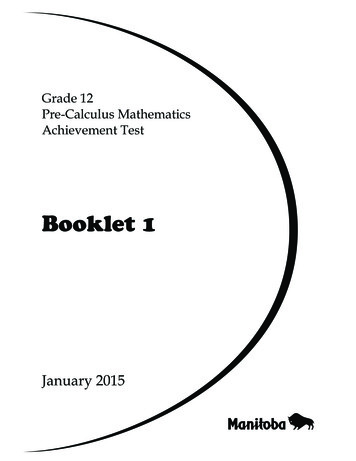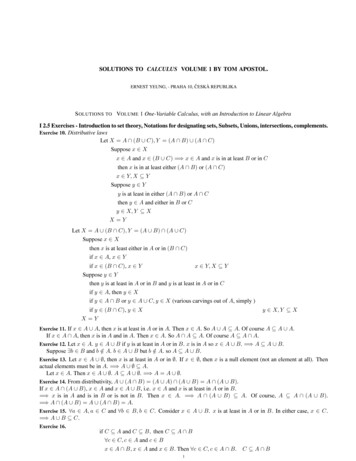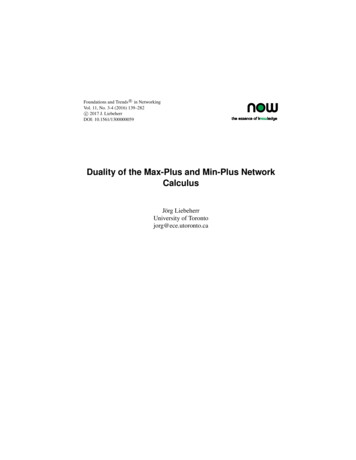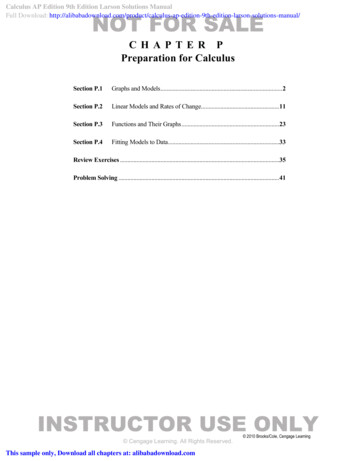
Transcription
The AP CalculusProblem Book Chuck Garner, Ph.D.
The AP Calculus Problem BookPublication history:First edition, 2002Second edition, 2003Third edition, 2004Third edition Revised and Corrected, 2005Fourth edition, 2006, Edited by Amy LanchesterFourth edition Revised and Corrected, 2007Fourth edition, Corrected, 2008This book was produced directly from the author’s LATEX files.Figures were drawn by the author using the TEXdraw package.TI-Calculator screen-shots produced by a TI-83Plus calculator using a TI-Graph Link.LATEX (pronounced “Lay-Tek”) is a document typesetting program (not a word processor) that is available free from www.miktex.org,which also includes TEXnicCenter, a free and easy-to-use user-interface.
Contents1 LIMITS1.1 Graphs of Functions . . . . . . . . . . .1.2 The Slippery Slope of Lines . . . . . . .1.3 The Power of Algebra . . . . . . . . . .1.4 Functions Behaving Badly . . . . . . . .1.5 Take It to the Limit . . . . . . . . . . .1.6 One-Sided Limits . . . . . . . . . . . . .1.7 One-Sided Limits (Again) . . . . . . . .1.8 Limits Determined by Graphs . . . . . .1.9 Limits Determined by Tables . . . . . .1.10 The Possibilities Are Limitless. . . . .1.11 Average Rates of Change: Episode I . .1.12 Exponential and Logarithmic Functions1.13 Average Rates of Change: Episode II . .1.14 Take It To the Limit—One More Time .1.15 Solving Equations . . . . . . . . . . . .1.16 Continuously Considering Continuity . .1.17 Have You Reached the Limit? . . . . . .1.18 Multiple Choice Questions on Limits . .1.19 Sample A.P. Problems on Limits . . . .Last Year’s Limits Test . . . . . . . . . . . .7891011121314151617181819202122232426272 DERIVATIVES2.1 Negative and Fractional Exponents2.2 Logically Thinking About Logic . .2.3 The Derivative By Definition . . .2.4 Going Off on a Tangent . . . . . .2.5 Six Derivative Problems . . . . . .2.6 Trigonometry: a Refresher . . . . .35363738394041.1.
2The AP CALCULUS PROBLEM .19LastContinuity and Differentiability . . . . . . . . .The RULES: Power Product Quotient Chain .Trigonometric Derivatives . . . . . . . . . . . .Tangents, Normals, and Continuity (Revisited)Implicit Differentiation . . . . . . . . . . . . . .The Return of Geometry . . . . . . . . . . . . .Meet the Rates (They’re Related) . . . . . . .Rates Related to the Previous Page . . . . . . .Excitement with Derivatives! . . . . . . . . . .Derivatives of Inverses . . . . . . . . . . . . . .Dérivé, Derivado, Ableitung, Derivative . . . .Sample A.P. Problems on Derivatives . . . . . .Multiple-Choice Problems on Derivatives . . . .Year’s Derivatives Test . . . . . . . . . . . . . .42434445464748495051525456583 APPLICATIONS of DERIVATIVES3.1 The Extreme Value Theorem . . . . . . . . . . . . . . .3.2 Rolle to the Extreme with the Mean Value Theorem . .3.3 The First and Second Derivative Tests . . . . . . . . . .3.4 Derivatives and Their Graphs . . . . . . . . . . . . . . .3.5 Two Derivative Problems . . . . . . . . . . . . . . . . .3.6 Sketching Functions . . . . . . . . . . . . . . . . . . . .3.7 Problems of Motion . . . . . . . . . . . . . . . . . . . .3.8 Maximize or Minimize? . . . . . . . . . . . . . . . . . .3.9 More Tangents and Derivatives . . . . . . . . . . . . . .3.10 More Excitement with Derivatives! . . . . . . . . . . . .3.11 Bodies, Particles, Rockets, Trucks, and Canals . . . . .3.12 Even More Excitement with Derivatives! . . . . . . . . .3.13 Sample A.P. Problems on Applications of Derivatives . .3.14 Multiple-Choice Problems on Applications of DerivativesLast Year’s Applications of Derivatives Test . . . . . . . . . .67686970717374767880818284868992.101. 102. 103. 104. 105. 106. 107. 108. 109. 110. 111. 113. 114. 116. 117. 1184 INTEGRALS4.1 The ANTIderivative! . . . . . . . . . . . . . . . . . . . . . . . . . . . . . . .4.2 Derivative Rules Backwards . . . . . . . . . . . . . . . . . . . . . . . . . . .4.3 The Method of Substitution . . . . . . . . . . . . . . . . . . . . . . . . . . .4.4 Using Geometry for Definite Integrals . . . . . . . . . . . . . . . . . . . . .4.5 Some Riemann Sums . . . . . . . . . . . . . . . . . . . . . . . . . . . . . . .4.6 The MVT and the FTC . . . . . . . . . . . . . . . . . . . . . . . . . . . . .4.7 The FTC, Graphically . . . . . . . . . . . . . . . . . . . . . . . . . . . . . .4.8 Definite and Indefinite Integrals . . . . . . . . . . . . . . . . . . . . . . . . .4.9 Integrals Involving Logarithms and Exponentials . . . . . . . . . . . . . . .4.10 It Wouldn’t Be Called the Fundamental Theorem If It Wasn’t Fundamental4.11 Definite and Indefinite Integrals Part 2 . . . . . . . . . . . . . . . . . . . . .4.12 Regarding Riemann Sums . . . . . . . . . . . . . . . . . . . . . . . . . . . .4.13 Definitely Exciting Definite Integrals! . . . . . . . . . . . . . . . . . . . . . .4.14 How Do I Find the Area Under Thy Curve? Let Me Count the Ways. . . .4.15 Three Integral Problems . . . . . . . . . . . . . . . . . . . . . . . . . . . . .
3CONTENTS4.164.174.184.19LastTrapezoid and Simpson . . . . . . . .Properties of Integrals . . . . . . . . .Sample A.P. Problems on Integrals . .Multiple Choice Problems on IntegralsYear’s Integrals Test . . . . . . . . . .5 APPLICATIONS of INTEGRALS5.1 Volumes of Solids with Defined Cross-Sections . . . . .5.2 Turn Up the Volume! . . . . . . . . . . . . . . . . . . .5.3 Volume and Arc Length . . . . . . . . . . . . . . . . .5.4 Differential Equations, Part One . . . . . . . . . . . .5.5 The Logistic Curve . . . . . . . . . . . . . . . . . . . .5.6 Differential Equations, Part Two . . . . . . . . . . . .5.7 Slope Fields and Euler’s Method . . . . . . . . . . . .5.8 Differential Equations, Part Three . . . . . . . . . . .5.9 Sample A.P. Problems on Applications of Integrals . .5.10 Multiple Choice Problems on Application of IntegralsLast Year’s Applications of Integrals Test . . . . . . . . . .119120121124127.135. 136. 137. 138. 139. 140. 141. 142. 143. 144. 147. 1506 TECHNIQUES of INTEGRATION6.1 A Part, And Yet, Apart. . . . . . . . . . . . . . . . . . . . . .6.2 Partial Fractions . . . . . . . . . . . . . . . . . . . . . . . . . .6.3 Trigonometric Substitution . . . . . . . . . . . . . . . . . . . .6.4 Four Integral Problems . . . . . . . . . . . . . . . . . . . . . . .6.5 L’Hôpital’s Rule . . . . . . . . . . . . . . . . . . . . . . . . . .6.6 Improper Integrals! . . . . . . . . . . . . . . . . . . . . . . . . .6.7 The Art of Integration . . . . . . . . . . . . . . . . . . . . . . .6.8 Functions Defined By Integrals . . . . . . . . . . . . . . . . . .6.9 Sample A.P. Problems on Techniques of Integration . . . . . .6.10 Sample Multiple-Choice Problems on Techniques of IntegrationLast Year’s Techniques of Integration Test . . . . . . . . . . . . . . .1591601611621631641651661681701731757 SERIES, VECTORS, PARAMETRICS and POLAR7.1 Sequences: Bounded and Unbounded . . . . . . . . . . . . . . . .7.2 It is a Question of Convergence. . . . . . . . . . . . . . . . . . .7.3 Infinite Sums . . . . . . . . . . . . . . . . . . . . . . . . . . . . .7.4 Tests for Convergence and Divergence . . . . . . . . . . . . . . .7.5 More Questions of Convergence. . . . . . . . . . . . . . . . . . .7.6 Power Series! . . . . . . . . . . . . . . . . . . . . . . . . . . . . .7.7 Maclaurin Series . . . . . . . . . . . . . . . . . . . . . . . . . . .7.8 Taylor Series . . . . . . . . . . . . . . . . . . . . . . . . . . . . .7.9 Vector Basics . . . . . . . . . . . . . . . . . . . . . . . . . . . . .7.10 Calculus with Vectors and Parametrics . . . . . . . . . . . . . . .7.11 Vector-Valued Functions . . . . . . . . . . . . . . . . . . . . . . .7.12 Motion Problems with Vectors . . . . . . . . . . . . . . . . . . .7.13 Polar Basics . . . . . . . . . . . . . . . . . . . . . . . . . . . . . .7.14 Differentiation (Slope) and Integration (Area) in Polar . . . . . .7.15 Sample A.P. Problems on Series, Vectors, Parametrics, and 7198.
4The AP CALCULUS PROBLEM BOOK7.16 Sample Multiple-Choice Problems on Series, Vectors, Parametrics, and Polar . . 201Last Year’s Series, Vectors, Parametrics, and Polar Test . . . . . . . . . . . . . . . . . 2038 AFTER THE A.P. EXAM8.1 Hyperbolic Functions . . . . . . . . . . . .8.2 Surface Area of a Solid of Revolution . . .8.3 Linear First Order Differential Equations8.4 Curvature . . . . . . . . . . . . . . . . . .8.5 Newton’s Method . . . . . . . . . . . . . .9 PRACTICE and REVIEW9.1 Algebra . . . . . . . . . . . . . . . . . . . . . . . . . .9.2 Derivative Skills . . . . . . . . . . . . . . . . . . . . .9.3 Can You Stand All These Exciting Derivatives? . . . .9.4 Different Differentiation Problems . . . . . . . . . . .9.5 Integrals. Again! . . . . . . . . . . . . . . . . . . . .9.6 Intégrale, Integrale, Integraal, Integral . . . . . . . . .9.7 Calculus Is an Integral Part of Your Life . . . . . . . .9.8 Particles . . . . . . . . . . . . . . . . . . . . . . . . . .9.9 Areas . . . . . . . . . . . . . . . . . . . . . . . . . . .9.10 The Deadly Dozen . . . . . . . . . . . . . . . . . . . .9.11 Two Volumes and Two Differential Equations . . . . .9.12 Differential Equations, Part Four . . . . . . . . . . . .9.13 More Integrals . . . . . . . . . . . . . . . . . . . . . .9.14 Definite Integrals Requiring Definite Thought . . . . .9.15 Just When You Thought Your Problems Were Over.9.16 Interesting Integral Problems . . . . . . . . . . . . . .9.17 Infinitely Interesting Infinite Series . . . . . . . . . . .9.18 Getting Serious About Series . . . . . . . . . . . . . .9.19 A Series of Series Problems . . . . . . . . . . . . . . .211212213214215216.217. 218. 219. 220. 222. 224. 225. 226. 227. 228. 229. 230. 231. 232. 233. 234. 236. 238. 239. 24010 GROUP INVESTIGATIONSAbout the Group Investigations . . . . . . . . . . . . . . . . .10.1 Finding the Most Economical Speed for Trucks . . . . .10.2 Minimizing the Area Between a Graph and Its Tangent10.3 The Ice Cream Cone Problem . . . . . . . . . . . . . . .10.4 Designer Polynomials . . . . . . . . . . . . . . . . . . . .10.5 Inventory Management . . . . . . . . . . . . . . . . . . .10.6 Optimal Design of a Steel Drum . . . . . . . . . . . . .247. 248. 250. 252. 254. 256. 259. 26211 CALCULUS LABSAbout the Labs . . . . . . . . . . . .1: The Intermediate Value Theorem2: Local Linearity . . . . . . . . . .3: Exponentials . . . . . . . . . . . .4: A Function and Its Derivative . .5: Riemann Sums and Integrals . . .6: Numerical Integration . . . . . . .241242243243243244244246
5CONTENTS7: Indeterminate Limits and l’Hôpital’s Rule8: Sequences . . . . . . . . . . . . . . . . . .9: Approximating Functions by Polynomials .10: Newton’s Method . . . . . . . . . . . . .277. 278. 279. 281. 283. 284. 286. 287. 289. 292. 293.295. 296. 297. 299. 301. 303. 305A FORMULASFormulas from Geometry . . . . . . . . . . . . . . . . . . . . . . . . . . . . . . . . .Greek Alphabet . . . . . . . . . . . . . . . . . . . . . . . . . . . . . . . . . . . . . . .Trigonometry . . . . . . . . . . . . . . . . . . . . . . . . . . . . . . . . . . . . . . . .309. 310. 311. 31212 TI-CALCULATOR LABSBefore You Start . . . . . . . .1: Useful Stuff . . . . . . . . .2: Derivatives . . . . . . . . . .3: Maxima, Minima, Inflections4: Integrals . . . . . . . . . . .5: Approximating Integrals . .6: Approximating Integrals II .7: Applications of Integrals . .8: Differential Equations . . . .9: Sequences and Series . . . .13 CHALLENGE PROBLEMSSet A . . . . . . . . . . . . . . .Set B . . . . . . . . . . . . . . .Set C . . . . . . . . . . . . . . .Set D . . . . . . . . . . . . . . .Set E . . . . . . . . . . . . . . .Set F . . . . . . . . . . . . . . . .267270272274B SUCCESS IN MATHEMATICS315Calculus BC Syllabus . . . . . . . . . . . . . . . . . . . . . . . . . . . . . . . . . . . . 316C ANSWERS329Answers to Last Year’s Tests . . . . . . . . . . . . . . . . . . . . . . . . . . . . . . . . 343
6The AP CALCULUS PROBLEM BOOK
CHAPTER 1LIMITS7
8The AP CALCULUS PROBLEM BOOK1.1Graphs of FunctionsDescribe the graphs of each of the following functions using only one of thefollowing terms: line, parabola, cubic, hyperbola, semicircle.1. y x3 5x2 x 12. y 1x4. y x3 500x 3x 58. y 9 x23. y 3x 25. y 7. y 9 x26. y x2 49. y 3x310. y 34x 5211. y 34x2 5212. y 1 x2Graph the following functions on your calculator on the window 3 x 3, 2 y 2. Sketch what you see. Choose one of the following to describe whathappens to the graph at the origin: A) goes vertical; B) forms a cusp; C) goeshorizontal; or D) stops at zero.13. y x1/317. y x1/414. y x2/318. y x5/415. y x4/319. y x1/516. y x5/320. y x2/521. Based on the answers from the problems above, find a pattern for the behavior of functionswith exponents of the following forms: xeven/odd , xodd/odd , xodd/even .Graph the following functions on your calculator in the standard window andsketch what you see. At what value(s) of x are the functions equal to zero?22. y x 1 25. y 4 x2 23. y x2 4 26. y x3 824. y x3 8 27. y x2 4x 5 In the company of friends, writers can discuss their books, economists the state of the economy, lawyers theirlatest cases, and businessmen their latest acquisitions, but mathematicians cannot discuss their mathematics atall. And the more profound their work, the less understandable it is. —Alfred Adler
9CHAPTER 1. LIMITS1.2The Slippery Slope of LinesThe point-slope form of a line ism(x x1 ) y y1 .In the first six problems, find the equation of the line with the given properties.28. slope:23;passes through (2, 1)29. slope: 14 ; passes through (0, 6)30. passes through (3, 6) and (2, 7)31. passes through ( 6, 1) and (1, 1)32. passes through (5, 4) and (5, 9)33. passes through (10, 3) and ( 10, 3)34. A line passes through (1, 2) and (2, 5). Another line passes through (0, 0) and ( 4, 3). Findthe point where the two lines intersect.35. A line with slope 25 and passing through (2, 4) is parallel to another line passing through( 3, 6). Find the equations of both lines.36. A line with slope 3 and passing through (1, 5) is perpendicular to another line passingthrough (1, 1). Find the equations of both lines.37. A line passes through (8, 8) and ( 2, 3). Another line passes through (3, 1) and ( 3, 0).Find the point where the two lines intersect.38. The function f (x) is a line. If f (3) 5 and f (4) 9, then find the equation of the linef (x).39. The function f (x) is a line. If f (0) 4 and f (12) 5, then find the equation of the linef (x).40. The function f (x) is a line. If the slope of f (x) is 3 and f (2) 5, then find f (7).41. The function f (x) is a line. If the slope of f (x) is23and f (1) 1, then find f ( 32 ).42. If f (2) 1 and f (b) 4, then find the value of b so that the line f (x) has slope 2.43. Find the equation of the line that has x-intercept at 4 and y-intercept at 1.44. Find the equation of the line with slope 3 which intersects the semicircle y x 4. 25 x2 atI hope getting the nobel will improve my credit rating, because I really want a credit card. —John Nash
10The AP CALCULUS PROBLEM BOOK1.3The Power of AlgebraFactor each of the following completely.45. y 2 18y 5652. x3 846. 33u2 37u 1053. 8x2 2747. c2 9c 854. 64x6 148. (x 6)2 955. (x 2)3 12549. 3(x 9)2 36(x 9) 8150. 63q 3 28q56. x3 2x2 9x 1851. 2πr 2 2πr hr h57. p5 5p3 8p2 40Simplify each of the following expressions.58.3(x 4) 2(x 5)6(x 4)59.11 x y y x9x2361. 5x3xy62.1 63.5x 760. 3x 4x11 yRationalize each of the following expressions. 3 9 72 3 64.67.74 3 x 63 2 5 68. 65.x 3 32 102x 8x 466. 9 2x 3 2x69. 1y y1 1x5x x 5 5 2 5 6 3 71.4 5 370. 72. x x 3 3Incubation is the work of the subconscious during the waiting time, which may be several years. Illumination,which can happen in a fraction of a second, is the emergence of the creative idea into the conscious. This almostalways occurs when the mind is in a state of relaxation, and engaged lightly with ordinary matters. Illuminationimplies some mysterious rapport between the subconscious and the conscious, otherwise emergence would nothappen. What rings the bell at the right moment? —John E. Littlewood
11CHAPTER 1. LIMITS1.4Functions Behaving BadlySketch a graph of each function, then find its domain. ! 1 r 2 1 r 1x2x 173. G(x) 76. V (r) 12x 3 x 1 r 1r ! 1/x x 1 t t 174. A(t) 77. U (x) x 1 x 1 3t 4 t 1 1/x x 178. f (x) 75. h(x) x x x x For the following, find a) the domain; b) the y-intercept; and c) all verticaland horizontal asymptotes.79. y x 2x82. y xx2 2x 880. y 1(x 1)283. y 81. y x 2x 3x2 2xx2 1684. y x2 4x 3x 4Choose the best answer.85. Which of the following represents the graph of f (x) moved to the left 3 units?A) f (x 3)B) f (x) 3C) f (x 3)D) f (x) 386. Which of the following represents the graph of g(x) moved to the right 2 units and down7 units
The AP Calculus Problem Book Publication history: First edition, 2002 Second edition, 2003 Thir

